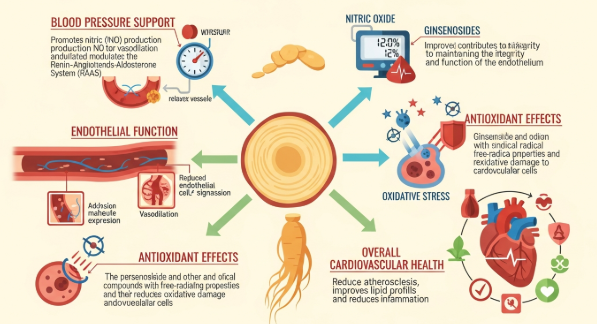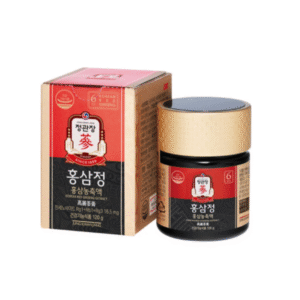High blood pressure, or hypertension, affects over a billion people worldwide and is a leading risk factor for heart disease, stroke, and kidney problems. Modern medicine often relies on prescription drugs to manage hypertension, but natural interventions such as Korean Red Ginseng (Panax ginseng) are increasingly studied for their complementary cardiovascular benefits.
This article explores how red ginseng works, the scientific evidence, safety considerations, and practical usage for supporting healthy blood pressure and vascular function.
⚠ Disclaimer: Red ginseng may support cardiovascular health but is not a substitute for prescribed antihypertensive medications. Always consult a healthcare professional before starting supplements.
1. Understanding Hypertension
Blood pressure measures the force of blood pushing against the arterial walls. Chronic elevation can result from multiple factors:
- Excess sodium intake and poor diet
- Sedentary lifestyle
- Stress and cortisol dysregulation
- Oxidative stress and endothelial dysfunction
- Genetic predisposition
Sustained high blood pressure damages arteries, increases heart workload, and accelerates cardiovascular disease. Traditional medications (ACE inhibitors, beta-blockers, diuretics) are effective but may come with side effects such as dizziness, fatigue, and electrolyte imbalance. This creates interest in natural, complementary approaches.
2. How Korean Red Ginseng Supports Blood Pressure
Red ginseng is an adaptogen — a natural substance that helps the body maintain balance under stress. Its active compounds, ginsenosides, provide vasculature, metabolic, and hormonal support, which are critical for maintaining healthy blood pressure.
2.1 Endothelial Function and Nitric Oxide (NO)
- Ginsenosides stimulate nitric oxide production, a molecule that relaxes blood vessels and improves circulation.
- Enhanced endothelial function reduces vascular resistance and helps maintain healthy systolic and diastolic blood pressure.
📎 Reference: https://pubmed.ncbi.nlm.nih.gov/19884332/
2.2 Antioxidant and Anti-Inflammatory Effects
- Chronic vascular inflammation and oxidative stress contribute to atherosclerosis and hypertension.
- Red ginseng reduces pro-inflammatory cytokines (TNF-α, IL-6) and neutralizes free radicals, protecting arterial walls from damage.
📎 Reference: https://www.ncbi.nlm.nih.gov/pmc/articles/PMC3659612/
2.3 Hormonal Modulation
- Stress can spike cortisol and adrenaline, causing transient increases in blood pressure.
- As an adaptogen, red ginseng helps regulate stress hormones, promoting cardiovascular resilience during daily stressors.
📎 Reference: https://pubmed.ncbi.nlm.nih.gov/21386932/
2.4 Lipid Profile and Cardiovascular Protection
- Red ginseng may support healthy cholesterol and triglyceride levels, further reducing cardiovascular risk.
- Lower LDL oxidation helps prevent arterial plaque buildup, synergizing with its blood pressure benefits.
📎 Reference: https://pubmed.ncbi.nlm.nih.gov/19705168/
3. Clinical Evidence
Multiple human studies have explored the effects of red ginseng on blood pressure and vascular function:
| Study | Participants | Intervention | Outcome |
|---|---|---|---|
| Park et al., 2012 | Adults with mild hypertension | 3 g/day red ginseng | Improved endothelial function; modest BP reduction |
| Choi et al., 2006 | Healthy adults | 2 g/day | Increased nitric oxide, enhanced circulation |
| Kim et al., 2011 | Adults with prehypertension | 2–3 g/day | Reduced oxidative stress, improved vascular flexibility |
| Lee et al., 2010 | Elderly adults | 3 g/day | Enhanced antioxidant defense and vascular elasticity |
Summary: While red ginseng may not replace prescription medication, it supports vascular health, reduces oxidative stress, and may help maintain healthy blood pressure, especially in mild or borderline cases.
4. Practical Use for Blood Pressure Support
- Dosage: 2–3 g/day standardized red ginseng extract
- Timing: Morning or early afternoon to avoid sleep interference
- Form: Capsules, powders, or fermented extracts (may enhance absorption)
- Duration: Clinical studies show optimal vascular benefits after 4–12 weeks
For best results, combine with low-sodium diet, regular exercise, stress management, and hydration.
5. Safety Considerations
- Generally safe for most adults
- Mild side effects: digestive upset, insomnia in sensitive individuals
- Avoid if taking blood thinners or high-dose antihypertensive drugs without medical supervision
- Not suitable as the sole treatment for severe hypertension
6. FAQ
Q: Can red ginseng lower blood pressure naturally?
A: Studies show it may modestly support healthy blood pressure, particularly in prehypertensive adults or as a complementary approach.
Q: How long until I notice effects?
A: Improvements in circulation or stress balance may appear in 2–4 weeks, with optimal results in 8–12 weeks.
Q: Is it safe for long-term use?
A: Generally safe up to 12 weeks in clinical trials. Extended use should be supervised by a healthcare provider.







